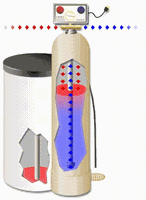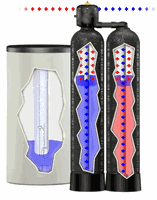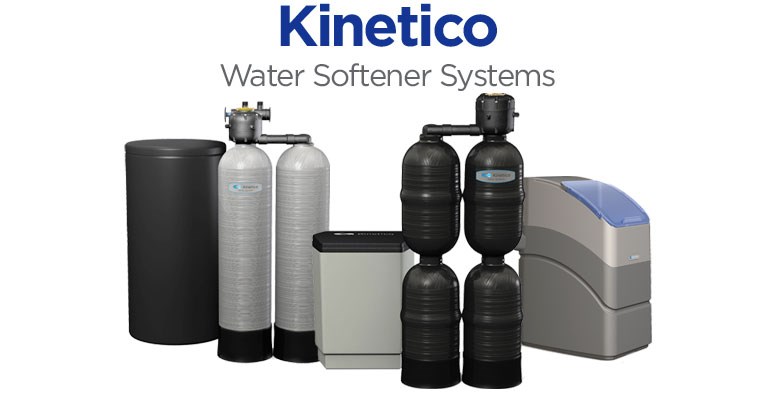What is the difference between an Electric Water Softener and a Non-Electric Water Softener?
![]()

A water softening system transforms hard water into soft water, which protects your home, many of the things in it and you from the harmful effects of hard water. How it works is somewhat simple. Hard water enters a water softener, and when it exits the softener, the water is soft.
Traditional, salt-based water softeners operate in two ways: with and without the use of electricity. It is important to understand the difference between a non-electric water softener and an electric water softener before deciding which is best for your home.
Learn More about Water Softener Systems
Traditional water softeners use a process called ion exchange to remove hardness minerals in the water. A water softener contains a resin bed where resin beads are charged with sodium ions. The ion exchange process occurs when hard water comes in contact with the resin, and the hardness ions in the water are exchanged for soft, sodium ions, which makes the hard water soft. Soft water is better for your water pipes and appliances, and eliminates problems like scale buildup, bathtub ring and hard water spots.
Once the resin is full of hard water ions, it must be cleaned so the water softener can continue producing soft water. How a softener regenerates, or cleans itself, is the real difference between electric water softeners and non-electric water softeners.
 Electric Water Softeners
Electric Water Softeners
Electric water softeners are water softeners that use electrical parts to initiate a regeneration. Most often, electric water softeners are single-tank systems.
How does an electric water softener work?
An electric water softener system uses a timer to track how long the system has been in service or how long it’s been since the last regeneration. At a pre-determined time, the system will regenerate or clean itself. This will happen whether or not the system needs to be cleaned. If the system needs to be cleaned before the pre-determined time, it has to wait, so your house will have hard water until regeneration time.
 Non-Electric Water Softeners
Non-Electric Water Softeners
A non-electric water softener does not use electricity to regenerate. Non-electric water softeners can be found in single-tank and multi-tank systems.
How does a non-electric water softener work?
A non-electric water softener doesn’t use a timer to regenerate or clean itself. Instead, a non-electric water softener uses a mechanical water meter to measure water usage. The system calculates how much water can be softened before it needs to regenerate, so it regenerates on-demand, when needed.
Which is better: An Electric Water Softener or a Non-Electric Water Softener?
Obviously, an electric water softener requires electricity, whereas a non-electric water softener does not, but that’s not the only difference. A non-electric water softener does not need to be located near a power source, so finding a good spot to install it is easier. In the event of a power outage, a non-electric water softener can still provide your home with soft water. And as the old saying goes, water and electricity do not mix. When possible, it is best to keep water away from electricity and electrical components to prevent any potential problems.
Since electric softeners use a timer to regenerate, a predetermined regeneration time is established, which may or may not be when the water softener needs to regenerate. Unless you use the same amount of water every day, it could regenerate too early or too late. A non-electric water softener regenerates after the system reaches its softening capacity, so it regenerates only when it needs to. This eliminates water waste, saves you money on your water bill if you have city water, and ensures you won’t have hard water breakthrough.
Have Your Water Tested To See
Which Softener Is Best For You
Contact A Kinetico Water Expert Today
Fill out your information below and we’ll have one of our authorized, independent Kinetico dealers contact you to schedule your free in-home water test.
Many water softeners using electricity only have one tank, so when the water softener regenerates, only untreated water is available to use. To eliminate this possibility, the electric timer is set to regenerate during off-hours when people are least likely to use water, but before the resin bed in the softener is likely to be exhausted. The catch is, this method does not account for unexpected increases in soft water usage or using less water than normal. If you have guests or water usage spikes, you may run out of soft water, or waste water and salt regenerating before it is needed.
The most obvious challenge is the electric components are more likely to break down, particularly when they are near water or in damp environments.
All things considered, many people find non-electric water softeners to be the best option.
Non-Electric Kinetico Water Softeners
If you decided a non-electric water softener is right for you, discover what makes a Kinetico non-electric water softener different.
Kinetico developed the first non-electric, twin tank, completely automatic water softener, and removed the pitfalls associated with electric units.
Learn More About Kinetico Water Softeners
Kinetico water softeners have two tanks joined by a single module that automatically regulates the functions of the water softener, including switching from one tank to the other when required. With Kinetico water softeners, adjustments aren’t necessary when overnight guests visit or you go on vacation. A meter measures the volume of clean soft water as it flows through a non-corrosive internal control mechanism.

The use of two tanks means Kinetico water softeners can regenerate using soft, clean water which is better than using hard water to regenerate, as most other systems do. The system also employs a counter-current regeneration process which is more salt and water efficient and more effective too. Plus, with two tanks, when one tank needs to regenerate, service switches to the other, so there is no “downtime” when soft, conditioned water is unavailable.
There is no risk of an electric shock either since Kinetico water softeners do not use electricity. Clocks, computers, electric valves, guest cycles, reset buttons, and vacation by-passes are unnecessary with Kinetico water systems too. Upkeep is reduced to the simple task of maintaining the salt in the brine drum. Kinetico makes having an unlimited supply of soft water, all the time, so easy without worry or waste.
Ready to improve your life with a non-electric water softener from Kinetico? Contact your local Kinetico dealer to schedule a water test today.
Contact An Authorized Kinetico Dealer To Schedule A Water Test Today

